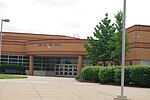River Hill Farm
River Hill Farm is a historic slave plantation located in Clarksville in Howard County, Maryland, United States. River Hill Farm resided on a land tract patented as "Four Brothers Portion". The house was built in the 18th century out of field stone with stucco covering. Outbuilding included a slave quarters. The 500 acre property was the home of Major Henry Owings of Owingsville. In 1972, Rouse used the River Hill farm as a game preserve while other sections were being developed. Howard Research and Development placed the Game Manager lived in the historic house. In 1974 The property was proposed for use as a landfill, but Alpha Ridge Landfill was selected. The house was not preserved or submitted for the historic registry by the Rouse Company. It was demolished for the development of Pointers Run.
Excerpt from the Wikipedia article River Hill Farm (License: CC BY-SA 3.0, Authors).River Hill Farm
Patuxent Freeway, Columbia River Hill
Geographical coordinates (GPS) Address Nearby Places Show on map
Geographical coordinates (GPS)
| Latitude | Longitude |
|---|---|
| N 39.194444444444 ° | E -76.915833333333 ° |
Address
Patuxent Freeway
21029 Columbia, River Hill
Maryland, United States
Open on Google Maps





